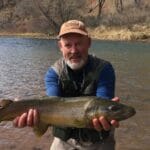According to one stereotype, a rancher’s commitment to the lifestyle is mainly self-serving. The fences they build are as much to keep the public out as to detain resident wildlife (translation: elk) for the purpose of selling high-dollar hunting opportunities. When not dewatering streams, they restore and stock them for their own fishing pleasure and that of paying anglers in search of lunkers in a crowd-free environment. Seeking their own private piece of western American folklore, more and more ranchers have shifted to the profession after enriching themselves elsewhere. These newbies wear the boots and drive the trucks. They irrigate fields and grow livestock, but mainly to shaft the tax man.
Ranchers not only bar access to prime hunting and fishing territory, but often subdivide their property. Roads and driveways are scraped, and wells are drilled into local aquifers. Speaking of drilling, some private lands sit atop substantial mineral and petroleum reserves, a sweet deal if there ever was one.
While there’s plenty to dislike about this scenario, there is far more to learn about the true role that private lands play across a greater landscape. The first thing to understand is that the stereotype of the rancher is just that. As such, it unfairly mischaracterizes who ranchers are, as well as the beneficial degree to which their actions cross property lines.
Motivated by profit and wise stewardship, a great many ranchers pay extremely close attention to trends in land health. They thin their timber stands, fence off riparian areas, address weed outbreaks, and engage in planned rotational grazing that keeps the range in good health for wildlife populations. They repair gullies and other erosional features that sap the land of its ability to store water and deliver it to our public fisheries. Speaking of fisheries, ranchers have negotiated water leases for in-stream flow.
Regardless of the size of a rancher’s bank account, all of this work not only needs to be done, but is hard.
Ranchers employ local workers and participate in their communities by supporting schools (where they send their children), fire departments, fundraisers and local businesses (because they are one). I know of several New Mexico ranches that invest resources specifically on species diversity. One such ranch is almost solely responsible for keeping the Rio Grande cutthroat trout off the Endangered Species List.
Many ranches include grazing allotments on nearby public lands, where producers are responsible for maintaining range conditions. Diligently-managed operations make a priority of monitoring the land and responding to problems and opportunities. During last summer’s severe drought, members of a grazing association I work with extinguished over 30 abandoned campfires in the regular course of riding their allotment and completing mundane chores. It is no small thing that the upland drinkers they maintain provide water for big game and other wildlife and are, unfortunately, frequently vandalized.
Granted, mistakes are made at the land’s expense. But the same holds true in all walks of life, including the environmentalist one, where undesirable results have arisen from the best intentions.

This is not tit for tat, but merely a factual statement in the context of an unpaved landscape that includes so many moving parts, millions of acres in public ownership, millions more in private, millions of intensely interested humans, along with animals, plants, water and soil that don’t know the difference between those things. It’s a massive, massive system that functions, or doesn’t, according to how its interconnected parts work together.
That’s where it gets tough, especially in a society wherein we’ve grown so certain of our unexamined judgments. Our opinions have grown rigid, our conflicts more intractable. Too many of us have reached a point of believing we can destroy our systems and rebuild from scratch without disastrous repercussions.
Imagine addressing climate change by eliminating the use of fossil fuels in one day. Imagine managing natural resources towards greater resiliency— something we badly need to do— by eliminating the rancher’s role or that of the environmentalist.
As you do this, imagine also the aftermath of a catastrophic wildfire, mountainsides of charred sticks and hydrophobic soil. That’s what starting from scratch looks like.
On the hill behind my home, I’ve spent the past four years walking among the pinons on the sandy dead soil remaining from sheep grazing in the distant past. My daily exercise is the work of arresting erosion or at least making it more constructive. Using rocks, logs, juniper boughs, railroad ties, scavenged construction waste and carpet fragments (lots of illegal dumping here), I’ve stuffed rills and gullies across about 100 acres of country. In many places, stormwater flows slower now. Gullies take serpentine paths, widening as they’ve filled with sediment. Water spreads onto new floodplains instead of cutting deeper.
I call this place my bunny ranch for the ecosystem I’d hoped to awaken with my putzing. First the grass came back, especially in the flat areas, and then it crept down the rain-graded slopes and gully banks. I’m cataloging more plant species all the time and I’ve seen lots of new wildflowers after our recent fat winter. Rabbit poop and fence lizards, birdsongs and insects were rare when this vanity project began. And now a pack of six coyotes walks a beat.
As fun as it’s been, I know the next monsoon will probably blow out some of my erosion structures. So I’ll have to fix them. That’s been my lesson, something real ranchers have known since the beginning. If something breaks you fix it, then fix it again. You make mistakes, you tweak. You make sure you’ve kept the parts, because as night follows day, you’re going to need them.
Toner Mitchell is the water habitat coordinator for TU in New Mexico.



